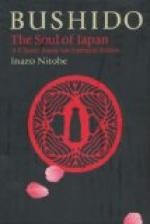From what has been said, it will not be surprising to note that the curriculum of studies, according to the pedagogics of Bushido, consisted mainly of the following,—fencing, archery, jiujutsu or yawara, horsemanship, the use of the spear, tactics, caligraphy, ethics, literature and history. Of these, jiujutsu and caligraphy may require a few words of explanation. Great stress was laid on good writing, probably because our logograms, partaking as they do of the nature of pictures, possess artistic value, and also because chirography was accepted as indicative of one’s personal character. Jiujutsu may be briefly defined as an application of anatomical knowledge to the purpose of offense or defense. It differs from wrestling, in that it does not depend upon muscular strength. It differs from other forms of attack in that it uses no weapon. Its feat consists in clutching or striking such part of the enemy’s body as will make him numb and incapable of resistance. Its object is not to kill, but to incapacitate one for action for the time being.
A subject of study which one would expect to find in military education and which is rather conspicuous by its absence in the Bushido course of instruction, is mathematics. This, however, can be readily explained in part by the fact that feudal warfare was not carried on with scientific precision. Not only that, but the whole training of the samurai was unfavorable to fostering numerical notions.
Chivalry is uneconomical; it boasts of penury. It says with Ventidius that “ambition, the soldier’s virtue, rather makes choice of loss, than gain which darkens him.” Don Quixote takes more pride in his rusty spear and skin-and-bone horse than in gold and lands, and a samurai is in hearty sympathy with his exaggerated confrere of La Mancha. He disdains money itself,—the art of making or hoarding it. It is to him veritably filthy




